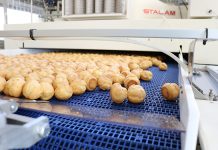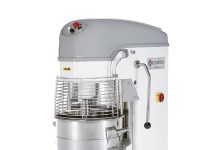 Pasta is a traditional Italian food made from extruded dough, usually composed of durum wheat semolina flour recognized to be the most suitable raw material for pasta production. This cheap food representing an important source of complex carbohydrates and is obtained by kneading, extrusion, pressing through a die and eventually dehydration of mixtures of meals and water. Pasta with ideal physical and sensory quality is characterized by strength and elasticity in the dough form, high tensile strength in the dried form, minimal cooking losses, minimal stickiness, and reasonable firmness after cooking. Anyway, fresh pasta market could have new inputs and increase its outputs if new ingredients and innovative technologies are used. Nevertheless, the diversification of raw material used in pasta making often needs changes to the traditional production making process. In particular, balanced formulations and adequate technological production process have to be adopted to counteract any changes in the rheological properties caused by the introduction of these new ingredients.
Pasta is a traditional Italian food made from extruded dough, usually composed of durum wheat semolina flour recognized to be the most suitable raw material for pasta production. This cheap food representing an important source of complex carbohydrates and is obtained by kneading, extrusion, pressing through a die and eventually dehydration of mixtures of meals and water. Pasta with ideal physical and sensory quality is characterized by strength and elasticity in the dough form, high tensile strength in the dried form, minimal cooking losses, minimal stickiness, and reasonable firmness after cooking. Anyway, fresh pasta market could have new inputs and increase its outputs if new ingredients and innovative technologies are used. Nevertheless, the diversification of raw material used in pasta making often needs changes to the traditional production making process. In particular, balanced formulations and adequate technological production process have to be adopted to counteract any changes in the rheological properties caused by the introduction of these new ingredients.
Why pasta should be fortified?
 Pasta is recognized as low in sodium and fat with no cholesterol and a rich source of complex carbohydrates; it is poor in fibers and lack in some essential amino acids such as lysine and threonine. To enhance its nutritional composition, pasta can be fortified with non-traditional ingredients: the success and diffusion of pasta also depends on the possibility of adding supplements such as legumes, cottonseed meal, egg albumin, whey proteins, yeast protein concentrates, rapeseed, fish protein concentrate and dried amaranth leaf flour. These ingredients are interesting from the point of view of fiber and protein sources, in order to satisfy the demand for healthy food and for a number of opportunities to the food industry in terms of the cooking quality and textural characteristics. Pasta quality and cooking characteristics are dependent upon the protein-starch matrix of the extruded pasta product: characteristics such as firmness, cooking loss, and stickiness of pasta can be associated with the protein content of the pasta, gluten strength, as well as the starch composition; indeed, technological treatments involve starch changes as the gelatinization and the retrogradation. As a result, some problems could arise in the preparation of pasta made from non-traditional raw materials: it must be made an accurate choice of supplements that not only do not change the sensory and technological properties of the product but also they have to be appropriate to improve them. For example, the incorporation of non-starch polysaccharides (NSPs) into pasta mix would have an effect on the tenacity of the protein–starch matrix binding and thus influence the cooking quality characteristics of pasta. In particular, soluble NSPs have been used in the food industry as thickeners and stabilizers, many of these, such as guar and xanthan, have the potential to form a hydrated polysaccharide-gum system within a food, altering the internal structure of that food and forming complex associations with protein and starch components. While insoluble NSPs tend to be used more as fillers: they generally lack this ability to form gel-like structures in association with other food components and can therefore cause loss of stability in food systems. Among these non-traditional raw materials, legumes represent an interesting source of proteins, fibers, vitamins and minerals, however, high level (35% w/w) of substitution can decrease the quality of pasta products.
Pasta is recognized as low in sodium and fat with no cholesterol and a rich source of complex carbohydrates; it is poor in fibers and lack in some essential amino acids such as lysine and threonine. To enhance its nutritional composition, pasta can be fortified with non-traditional ingredients: the success and diffusion of pasta also depends on the possibility of adding supplements such as legumes, cottonseed meal, egg albumin, whey proteins, yeast protein concentrates, rapeseed, fish protein concentrate and dried amaranth leaf flour. These ingredients are interesting from the point of view of fiber and protein sources, in order to satisfy the demand for healthy food and for a number of opportunities to the food industry in terms of the cooking quality and textural characteristics. Pasta quality and cooking characteristics are dependent upon the protein-starch matrix of the extruded pasta product: characteristics such as firmness, cooking loss, and stickiness of pasta can be associated with the protein content of the pasta, gluten strength, as well as the starch composition; indeed, technological treatments involve starch changes as the gelatinization and the retrogradation. As a result, some problems could arise in the preparation of pasta made from non-traditional raw materials: it must be made an accurate choice of supplements that not only do not change the sensory and technological properties of the product but also they have to be appropriate to improve them. For example, the incorporation of non-starch polysaccharides (NSPs) into pasta mix would have an effect on the tenacity of the protein–starch matrix binding and thus influence the cooking quality characteristics of pasta. In particular, soluble NSPs have been used in the food industry as thickeners and stabilizers, many of these, such as guar and xanthan, have the potential to form a hydrated polysaccharide-gum system within a food, altering the internal structure of that food and forming complex associations with protein and starch components. While insoluble NSPs tend to be used more as fillers: they generally lack this ability to form gel-like structures in association with other food components and can therefore cause loss of stability in food systems. Among these non-traditional raw materials, legumes represent an interesting source of proteins, fibers, vitamins and minerals, however, high level (35% w/w) of substitution can decrease the quality of pasta products.



